6 Best Practices to Maximize your Landing Page Conversion
Unlike your website, landing pages are specific goal-oriented & content-tailored pages designed to convert your visitors. The objective of a landing page is to maximize the conversion of visitors toward your defined goals. Most often, this goal is to convert your visitors into identified leads, marketing-qualified prospects, clients, and even ambassadors. This means that landing pages should not be filled with information that may dissuade or confuse a prospect from taking the desired conversion action, and every piece of text and content needs to be optimized to guide your visitor to take this action. Landing pages for any product or service should be direct and only contain relevant information for your customer, and it should have the visitor’s end-goal in mind.
Whether this is your first time building a landing page, or you aim to improve your existing landing pages, here are 6 best practices that will greatly improve your landing page conversion rate.
1. Creating a captivating header
The header is the first thing your visitors notice when they come to your landing page. Therefore, you need to make that header/banner a strong headline that will immediately catch their attention and make them want to stay and explore your page.
Don’t forget that often, landing pages are linked to paid campaigns, meaning now that you’ve paid for this visitor to come to your page, you want to make them stay as long as you can on your page and convert them. This way, you maximize your investment and decrease the bounce rate. Nowadays, most people have a ‘browsing’ mentality, meaning they will easily switch & click between pages and search results and go back to the previous page if they don’t see something captivating in the first few seconds. Both the message, as well as the visual aspect, are crucial here. You can captivate your visitors by expressing the value of what you offer, by referring to eye-opening content that will be shared later on the page, and structuring your message in the headline effectively.
2. Avoid lengthy, tiresome paragraphs
You would want your landing page to be impressive, clear, and get straight to your visitors’ minds; therefore, lengthy paragraphs are an absolute ‘no’. Additionally, lengthy paragraphs affect how visitors perceive your value and services.
How? Usually, they expect to see the answer to their questions, or a solution to their problems, quickly when visiting a landing page, so they don’t have to search through a wall of text. Presenting your information in lengthy paragraphs may leave the impression of being inefficient and unprofessional. Play with colors, images, videos and formatting to provide the answers you believe your visitors are looking for.
3. Remove navigation
Your landing page is crucial in deciding whether a visitor becomes a lead, so you want them to submit a contact form or take other desired actions; hence, you want to eliminate all the factors that may make them leave the page or may be of any distraction. Your page should be rich in call-to-action content and these interactions should be the only ones on your page. Removing all extra site navigations will let your visitor pay complete focus on the content at hand, rather than being distracted by other links on the website. Alternatively, you can keep a visually similar header or footer but remove any clickable links on logos and other actions that might redirect visitors away from your landing page, while maintaining the overall website look & feel.
4. Include social sharing icons
Though you should remove all distracting navigations, this doesn’t include the social media icons. Rather, you should program them so that visitors can easily share your content with their network. This way, you may reach a wider audience and attract more potential prospects. Choose the right social platforms that match with the identity and tone of voice of your business, campaigns, and the message of the landing page.
5. Provide relevant testimonials
For both products or services, customers want to read reviews before making a purchase or partnering with any service provider. This creates an important feeling of trust. Very often, visitors will not even fact-check these testimonials or reach out to references, but it does give your company a feeling of trustworthiness that will be essential to bring forward the desired conversion.
6. Keep the visitors goals in mind with tailored content
Know why the visitor clicked on your page and what content they could be looking for. You can view your Google Search or Ads queries to learn more about their behaviour and set up segmented, tailored, dynamic content using certain technologies to ensure that, depending on the visitor’s intention, specific messages and pictures are shown. By implementing neuromarketing principles and taking into account the visitor’s motivation for going to your page, you can ensure maximum conversion. And if you notice there is a disconnect between your page and the visitor’s motivation, don’t forget to configure your negative keywords to optimize your budgets and reduce your bounce rates.

Let’s Talk
Solving business challenges with clever communications strategies is what we do best. Let’s discuss how we could help you.
How to Decode Mysterious Social Media Algorithms: Part 2
This is a continuation of our how to decode mysterious social media algorithms series. In Part 2 we will discuss how the algorithm differs per social media platform.
Social media platform algorithms
Social media algorithms are automated calculations based on data that determine which content users see on their feed and in which order. If you want to learn more about them, read Part One of this article here. Social media algorithms can be complicated, are ever changing and evolving – with updates, tweaks and changes pushed out frequently which are hard to keep up with. But we have you covered. With our hacks you can go after the holy grail – organic traffic. Read on below as we take a peek under the hood of Facebook’s, Instagram’s and LinkedIn’s algorithm.

Facebook is all about network and relationship. More than 2.7 billion users use Facebook globally[1] and the average engagement rate on Facebook is 0.27%[2]. Like all other platforms, the Facebook algorithm will show the posts that are most relevant to its users.
- Relationship– Who shared the post? Facebook ranks content from friends and family above brands.
- Content type– What type of content do your viewers engage with the most? (Videos, Images, text etc.)
- Popularity– How is the post performing so far? Are people engaging with the post?
- Recency– How recent is the post? Newer posts are ranked higher in the newsfeed.
3 tips for making Facebook’s algorithm work for you:
- Longform video content– In 2021, video is the king of content. By 2022, 82% of all internet traffic will be video content[3]. Video generates more engagement than any other form of content. The longer the video, the longer the audience will engage with your post, which will increase the score of the post and will be rewarded by the algorithm.
- Facebook stories – The good news is that Facebook stories are not (yet) led by its algorithm. Take advantage of this and make stories a regular part of your content strategy. Dynamic stories present numerous possibilities to create engagement. Use stories to promote a post, showcase new products, and share tips and tricks.
- Engage with your audience– Remember Facebook is all about networking! Reply to your audiences, ask questions (in the caption or comments), and find other ways to boost interaction. Join Facebook groups where your audience resides and drive or participate in conversations. Again, experiment with different outlets to engage, explore FB live and stories, and be where the audience wants you to be.
Instagram is the largest photo and video sharing platform worldwide. Instagram’s organic engagement rate stands at 1.22% in 2021[1]. Similar to its parent company Facebook, Instagram feeds revolve around what the users care about the most.
Instagram ranks content based on:
- Interest– Content is based on the interests of the user.
- Recency and frequency– Recent posts are prioritized over old posts. Frequency of posting is also rewarded.
- Relationship– Instagram prioritizes posts from friends and family over posts from brands.
- Usage– The more time users spend on your post, the higher your content’s score will be.
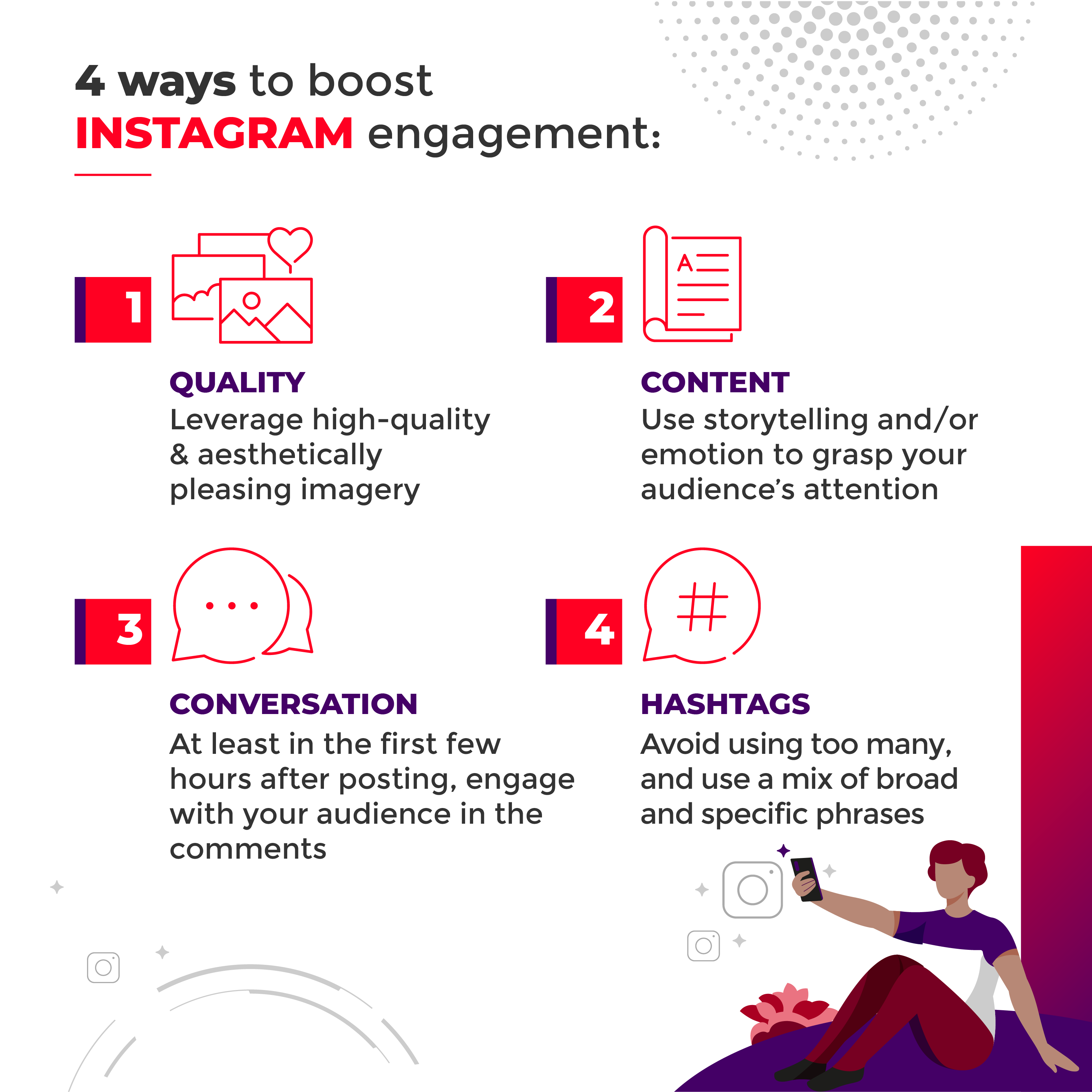
3 tips for making Instagram’s algorithm work for you:
- Content quality– Great content in terms of quality and information gets rewarded. The most shared content on Instagram is often the most visually striking. Use visuals that stand out, are high quality, and use storytelling with a sprinkle of emotion. That should do the trick.
- Engagement– The first few hours after you post are critical for engagement. If your post can gather engagement in the first 3 hours, Instagram’s algorithm will reward the post and increase the reach of the post[2]. So, optimize your caption to engage with your audience and encourage them to save, like share your content. Use various posting options like Stories, Feed, Reels, Live and IGTV. Be wherever your audience is and provide them various types of content to consume. Leverage Instagram stories to drive engagement using polls, questions, sliders or to just promote your most recent post.
- Hashtags– Hashtags aren’t useful on most other platforms but are still relevant for Instagram. They can help attract new eyes and skyrocket the reach. Target relevant hashtags with up to 10k -200k posts depending on your industry to provide the right kind of traffic. Avoid using too many hashtags, as this will most likely flag your post as spam by Instagram’s algorithm. Stick to a sweet number of 6-8 highly targeted hashtags.
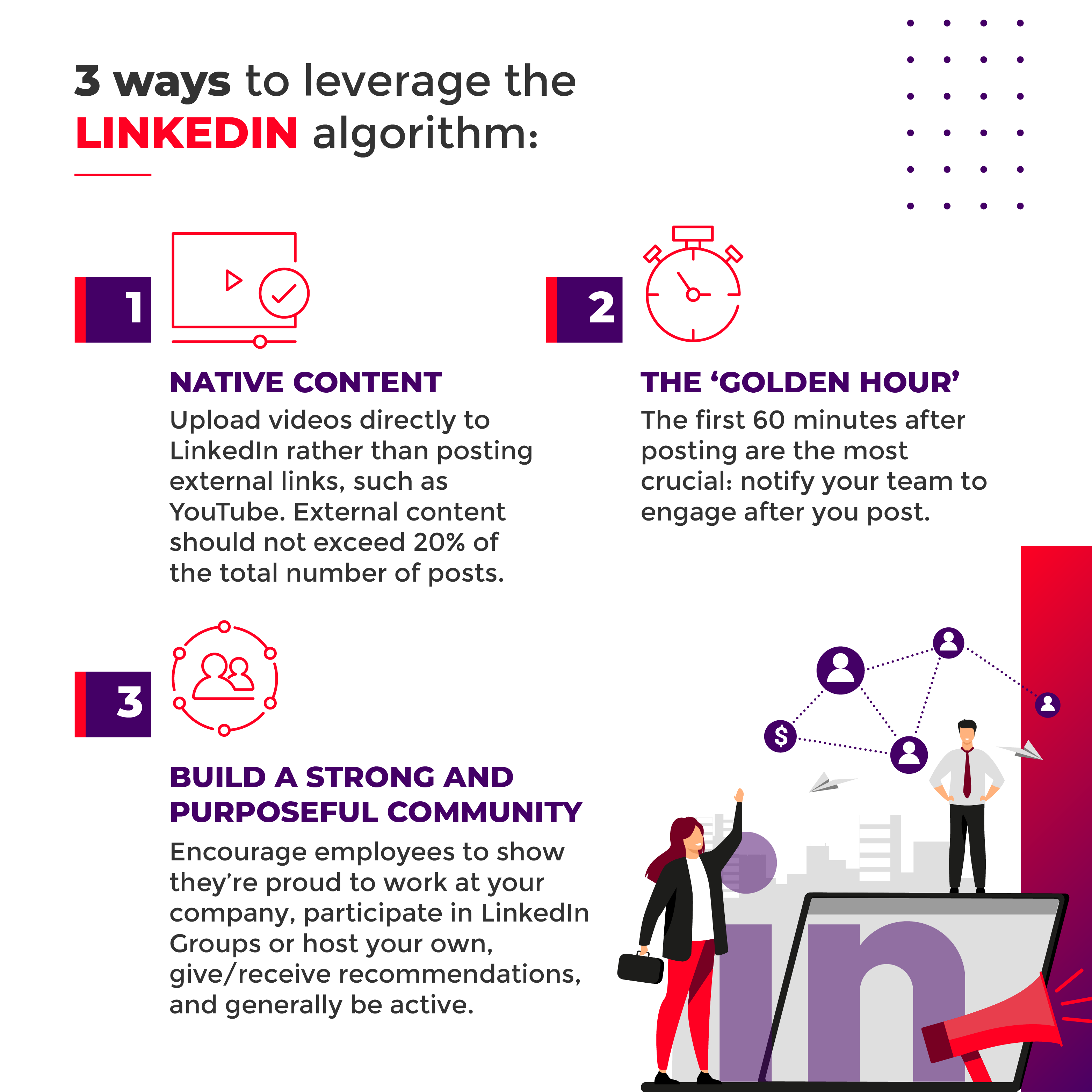
LinkedIn is the world’s largest professional network and B2B marketers’ preferred platform for content distribution. The average engagement rate on LinkedIn has been 0.35% in 20215. Also, 89% of B2B marketers use LinkedIn for content sharing6.
LinkedIn ranks its content based on:
- Content quality – LinkedIn’s algorithm categorizes all posted content into three clear categories: ‘spam,’ ‘low quality,’ and ‘clear.’ The objective is to create your content so it will be successfully categorized as ‘clear.’ This can be achieved by creating/posting content which is favored by its algorithm:
- Native content such as text posts, images with text, and videos with text. Infographics are highly recommended along with the usage of LinkedIn’s own native video format instead of sharing YouTube links. Videos still seem to have a slight advantage over static content.
- Question based posts.
- The latest news from the relevant industry and upcoming trends.
- Employee recognition, human stories with long captions (career advice, work/personal experiences with life lessons), personal/ business accomplishments.
- ‘Meaningful’ engagement – The algorithm will prioritize content that has received a high amount of engagement. LinkedIn prefers meaningful engagement in the comments section, which means posts with lengthy, quality comments are awarded over mere likes, reactions, or even links posted as comments. Furthermore, if the audience spends significant time digesting your content/posts, the algorithm improves the likelihood of more people seeing your content on LinkedIn.
- Influencers – If you tag users with a high reach on LinkedIn (especially if they engage with your content), such as C-suite executives from big corporations, your content will be much more likely to increase its reach.
- Frequency of posting content – The algorithm favors consistency over random/ad hoc posts. The algorithm will reward consistency, and posting 1-2 times per week seems to be the sweet spot.
3 tips for making LinkedIn’s algorithm work for you:
- Native content – Videos uploaded using LinkedIn’s native format is preferred over external links such as YouTube. Authors/creators replying with external links in comments may also see their content/posts penalized with lower reach/engagement.
- External content should not exceed 20% of the total number of posts.
- Use the LinkedIn Publisher Tool, as the platform is making conscious efforts to promote/push posts which originate from their Publisher tool, which end up on LinkedIn Pulse (now integrated with the homepage feed).
- Leverage the ‘golden hour’ – The first 60 minutes after posting content are the most crucial part of your content marketing success – this is the ‘golden hour’ for your post. If reaction to your post is low during this time, the likelihood of your post performing well are low. Aim for 20+ engagements (replies or comments) in the first half by notifying your employees about the post. Use your internal communication mediums, such as Slack, Trello, or Teams, to inform everyone about the post and ask them to participate.
- Build a strong and purposeful community – Encourage employees to show they’re proud to work at your company, encourage partners to show they collaborate/work with you, participate in LinkedIn Groups or host your own, give/receive recommendations, join conversations, use LinkedIn messaging to share content privately with smaller sets of audiences, and be active on the network.
- React/respond to every comment on your post. Engaging with new followers is a must.
- Use mentions and hashtags.
- If you’re sharing someone’s quote or interview, give them credit or inform them by tagging them in your post so that they can share it with their followers too.
So, what next?
Now that you have the secret sauce to leverage social media algorithms across all platforms along with platform specific strategies to increase the reach of your content, it’s time to get started. Social networks are all about community and sharing the solution that your audience is seeking. Whether you are taking your first steps in setting up the social media presence for your brand or are a seasoned veteran – persistence is key. It’s important to keep evolving your social media and content strategy as the algorithms evolve. Work with the algorithm and it will reward your content and help grow your account.
Looking for more marketing expertise?
Sign up for our newsletter
"(Required)" indicates required fields
YOU MAY ALSO LIKE…

How to add Video to your Digital Marketing Strategy
Digital marketing without video has become unthinkable. Now more than ever, marketers are using video to get their message across.
Read moreHow to add Video to your Digital Marketing Strategy
Digital marketing without video has become unthinkable. Now more than ever, marketers are using video to get their message across.
Read to learn how to implement video on your next digital marketing strategy.
Why Video?
Video is a very versatile and engaging content format.
It has the opportunity to gives us a real-life picture of what is going on. Deployable on multiple platforms, consumers love video because it’s easy to digest, entertaining and engaging. For marketers, it’s appealing because it gives a great return on investment through many different channels.
Search engines love video because they view it as high-quality content. The use of video on a web page can give your SEO an enormous boost, as long as the video is optimized correctly. It is therefore very important to include the right keywords, a clear meta description, and a strong title.
Here’s the facts:
· 97% of marketers claim that videos help customers better understand their products.
· 81% of businesses are now using video as a part of their digital marketing strategy.
· By 2022, online video content is predicted to command more than 82% of all web traffic (15 times higher than it was in 2017).
· 90% of consumers claim a video will help them when making a purchasing decision.
Different Types of Video?
Video is a great way to humanize your brand by showcasing real employees, customers, or partners. It also allows you to build credibility by publishing informational content that helps your target buyer.
There are a lot of video types to choose from. Here are some examples:
- Explainer videos are perfect to educate people about your product or service by explaining the process step-by-step. This can be done with animation or live-action video.
- Interviews/testimonials can start a dialogue between sides. You can invite a special guest, a client, or even an influencer. If you are creating videos featuring guest experts, for instance, you can always re-use the audio and market it as a podcast.
- Product reviews and demos help your audience understand, and maybe convince them to buy, your product or service. A product review feels more “real” to the audience than an advertisement.
- Live video is the best chance to get up close and personal with your audience, and it works well on social channels in particular. Real-time content is great for:
(1) Offering a feel of face-to-face interaction
(2) Building trust
(3) Offering audiences casual, interesting updates (eg: behind the scenes)
How to Use Video in Campaigns?
Back in 2014, Google invented a guide for increasing the viewership of your YouTube videos. They called it “Hero, Hub, Hygiene.” Since then, this guide has proven so effective that marketers are using it across other platforms as well.

The idea is based around 3 different content types, each with their own purpose in the buyer’s journey.
HERO
The “Hero-movie” is brand focused, driven by emotion, and a high-quality production.
It’s intended to reach a wide audience, limited to 1 to 3 campaigns a year (depending on the budget) and should raise brand awareness, familiarity, and create a connection with the public.
A good example is Nike’s ‘Just do it’ campaign. Appealing (emotional) movies that speak to a wide audience without going into the details of their products.
HUB
“Hub content” is regularly scheduled content that provides a reason to subscribe to a channel and return on a regular basis. Episodic and formatted series work best as hub content.
Some good examples of this are: vlogs, interviews/testimonials, explainer videos, and demos.
HYGIENE (aka HELP)
You know the audience you want to reach. But to draw viewers to your channel, you need to capture their intent — that is, understand what they’re searching for when they come to YouTube. Use search insights to find the most frequent searches (aka “queries”). Which queries can your brand credibly answer?
Start making videos that quickly and clearly answer these queries. These videos are called “help content.”
“Help content” means your channel’s basic, always-on videos. These could also include tutorials that answer the most popular search queries in your content area.
Using this 3H model can help you plan and structure your content while serving every customer in the buyer’s journey.
Looking for more marketing expertise?
Sign up for our newsletter
"(Required)" indicates required fields
YOU MAY ALSO LIKE…

How to add Video to your Digital Marketing Strategy
Digital marketing without video has become unthinkable. Now more than ever, marketers are using video to get their message across.
Read moreHow to Decode Mysterious Social Media Algorithms: Part 1
Social media algorithms can seem like a puzzle to marketers. We have broken down this mystery to help your content perform better and appear more frequently on your customer’s feed.
What are social media algorithms and why do they exist?
Social media algorithms are automated calculations based on data that determine which content users see on their feed and in which order.
The platforms determine which content to show based on the behavior patterns of the user, such as which content they have engaged with in the past, what the platform thinks might interest the user, pages liked, keywords searched, and so on. In short, the platforms want to provide the best customized user experience, so they will show the user the kind of content they would like to see and engage with.
There are tons of photos, videos and posts uploaded on every social media platform every day. (Facebook: 300m photos uploaded/day, Instagram: 95m photos and videos shared/day, YouTube: 4,1m videos watched/ minute)
Without the algorithms, it would be impossible for the platforms to filter through all this vast content. And ultimately, the user experience would decline. Before the prevalence of these algorithms, most social media platforms displayed content to their users in reverse chronological order (latest content first). Over time, social media platforms have made paradigm shifts in the user experience by developing sophisticated algorithms which filter the content for the user, providing each user with a personalized experience based on their patterns of social media usage and preferences. For example, content published by the user’s “close” friends (i.e. contacts with whom the user interacts most frequently), will be displayed at the top of the user’s feed. Another example would be content published by accounts/pages managed by brands with whom the user engages with most on the platform.
From the perspective of these social media platforms, their objectives are not only to provide the best experience to the average user but also to provide a platform for brands to publish customized, targeted advertisements to the user community. This is great for the end user. However, for marketers, this impacts the reach of their content.
How do they work?
Social media algorithms exist to deliver relevant content to users. Sometimes the social media companies are transparent with their community about how to make their content rank high on their platforms, however, most social media companies prefer to be ambiguous and vague about the specifics of their algorithms.
Algorithms are based on machine learning, computational and statistical theories, and advanced data mining/analysis/processing techniques which allows the social media platform to sift through the tons of content uploaded every second by the user community. Pre-defined parameters and rules rank/categorize the content based on quality, engagement, geolocation, etc. The algorithms are highly confidential, intellectual proprietary property of the social media companies and as such, there is no definite way to find out how these algorithms work at a given point in time. Also, the algorithms are constantly evolving as social media companies keep tweaking the algorithms from behind the scenes without any notice to the user community. The best that marketers and brands can do in the face of this constant flux is to systematically experiment with their content strategies in tandem with whatever the platform reveals about its algorithm.
General tips to work with the algorithms on all social networks
- Increase engagement– Engagement is not just a buzz word. The more engagement garnered by a post, the more likely that it will be rewarded by the algorithm in terms of its reach within the user community. Asking questions, driving dialogue with other users via comments, likes, shares, and saves, are sure shot recipes to spread the reach of specific content. It can also help to tag relevant accounts (e.g., with a wider reach), when appropriate, to one’s post. Overall, these actions encourage users or other brands to engage with one’s content thus boosting its reach and engagement.
- Optimize launch windows for your content– Post content when your audience is most likely to be active. For B2B brands, this would be during specific time windows in the mornings (when many users commute to school/office and start their day), mid-morning (break time and lunch), evening (wrapping up/commuting) and the night (before going to bed). To target users from different geographies, posts must be aligned to the time zone of the users, and other practical realities (e.g., the weekend in the Middle East is Friday-Saturday). Marketers must put themselves in the shoes of their audiences as to when they would be most interested in the content.
- Frequency– Social media algorithms will reward accounts/pages that post on a frequent basis rather than every now and then. Marketers must plan ahead using content calendar and content scheduling tool to define and create the posts upfront with exact dates and times.
- Maximize video content– All social media networks reward native video content (video published on the platform and not an external link). Algorithms and users alike love video content, and platforms have been clear that they rank video content higher. Be sure to add subtitles to the videos, as adding subtitles increases the video views by 40%[1].
- Captions matter– Captions will increase the likelihood of your content connecting with your audience. Ensure that the caption does not seem too “sales-y.” Some great ways to develop captions is through storytelling and emotions, a touch of humor, including a CTA, etc., so experiment between long form and short form. Furthermore, captions on videos are highly recommended to capture the attention of the average social media user scrolling through the platform with their volume on mute.
- Experiment with your content– There is no rulebook, so brands must tweak and evolve their content strategies to figure out what works best for them. Try out:
- Different types of content– Post a variety of images, videos, gifs, etc., and see which give you best results.
- Different times of posting– Post at different times and the metrics will show when your posts receive the highest engagement.
- Long captions vs. short captions– Long captions can be used for storytelling and are known to engage users for longer periods. However, long captions may not be suitable to all types of content.
- Encourage advocates to engage with and push your content– Advocates can be your employees, brand ambassadors or influencers who will engage with your content, share with their network and give the right push for the algorithm to recognize your content and amplify its reach.
So, what next?
Every social network has its own way to curate their users’ feeds. It’s important to remember that algorithms are constantly evolving, so marketers will also need to constantly evolve their strategies. Knowing how the algorithms work is necessary to grow your social presence in the long term. While these strategies can help amplify the reach of your content, they’re not “one size fits all.” It’s essential to experiment until you find what fits and works for your brand.
And, for tips on each platform separately, keep an eye out for part 2 coming soon!
Looking for more marketing expertise?
Sign up for our newsletter
"(Required)" indicates required fields
YOU MAY ALSO LIKE…

How to add Video to your Digital Marketing Strategy
Digital marketing without video has become unthinkable. Now more than ever, marketers are using video to get their message across.
Read moreEnsure Your Social Media is as Impactful as Possible
Social media is a vital part of today’s society, and as such, it must be built on a foundation of inclusion. Check out our accessibility checklist below to ensure your social media is as inclusive and impactful as possible!
Accessible Social Media = Impactful Social Media
Mach Media has always made a sincere commitment to Diversity, Equity, and Inclusion (DEI). In our industry of marketing and communication, there are countless areas where these values need to be upheld.
Social media is a vital part of today’s society, and as such, must be built on a foundation of inclusion. While some people may choose to abstain from social media, others are not able to engage because of content structures that do not take their specific needs into account.
Being alienated from something like social media, a platform designed as a universal space where anyone and everyone is encouraged to contribute, can be quite upsetting for your audiences and will lead to missed engagement opportunities. When your social media is accessible to wider audiences, this is when you can make a large and lasting impact!
Social Media Accessibility Guidelines
But there’s good news! You can take steps to ensure your social media is as accessible as possible, and therefore as impactful as possible.
We’ve put together this checklist to help:
- Ensure your videos and images are at least 150-dpi for clear imagery
- Use simple, sans serif fonts with adequate spacing between letters so the words are easier to read
- Use at least a 40-point font size for text within images so they are big enough to read
- To make your text easier to read, limit the number of lines in each image and leave plenty of space above and below each line
- Apply the “5 by 6” rule: only 5 words per line and 6 lines per slide/image so slides/images are easier to comprehend
- Add alt-text and image descriptions for any charts, graphs, icons, images, pictures, shapes, or other media. Make sure it is descriptive enough that someone could understand what is displayed in the image without having to view it.
While this checklist can’t guarantee the inclusion of everyone, it is certainly a good start and worth the extra effort.
Looking for more marketing expertise?
Sign up for our newsletter
"(Required)" indicates required fields
YOU MAY ALSO LIKE…

How to add Video to your Digital Marketing Strategy
Digital marketing without video has become unthinkable. Now more than ever, marketers are using video to get their message across.
Read moreSocial media marketing doesn’t need to be a guessing game. Keep reading and discover how you can ensure your social media efforts are yielding the best results.
5 Simple Steps to Social Media Benchmarking
You can always take a quick glance at your follower count or engagement rate to see if it’s increased within the past 30 days and deem that as either “successful” or not, but how is that going to help better your social media content or measure return on investment?
Instead, benchmark your social media against your competitors and leaders within your space, and then make data-driven decisions to advance your own social media.
As marketers, conducting competitive benchmarking is nothing new. We already use it to measure our other marketing efforts, like SEO and advertising, so why not take the same approach with social media?
A recent survey conducted by Sprout Social found that “60 percent of executives identified investing more resources into social media as a key way to gain a competitive edge.”
Below, we’ve outlined 5 easy steps that you can use to develop your benchmarking exercise. Let this article be your ultimate social media benchmarking guide!
1. Identify Your Competitors
It’s important to take time to decide which competitors to track. Typically, we encourage our clients to choose between 3-5 competitors that fall into different levels of competition. For example, you can choose a company with whom you are in direct competition, is the same size and has a similar revenue, or you can choose a company that you aspire to be like, which is larger and has more social influence.
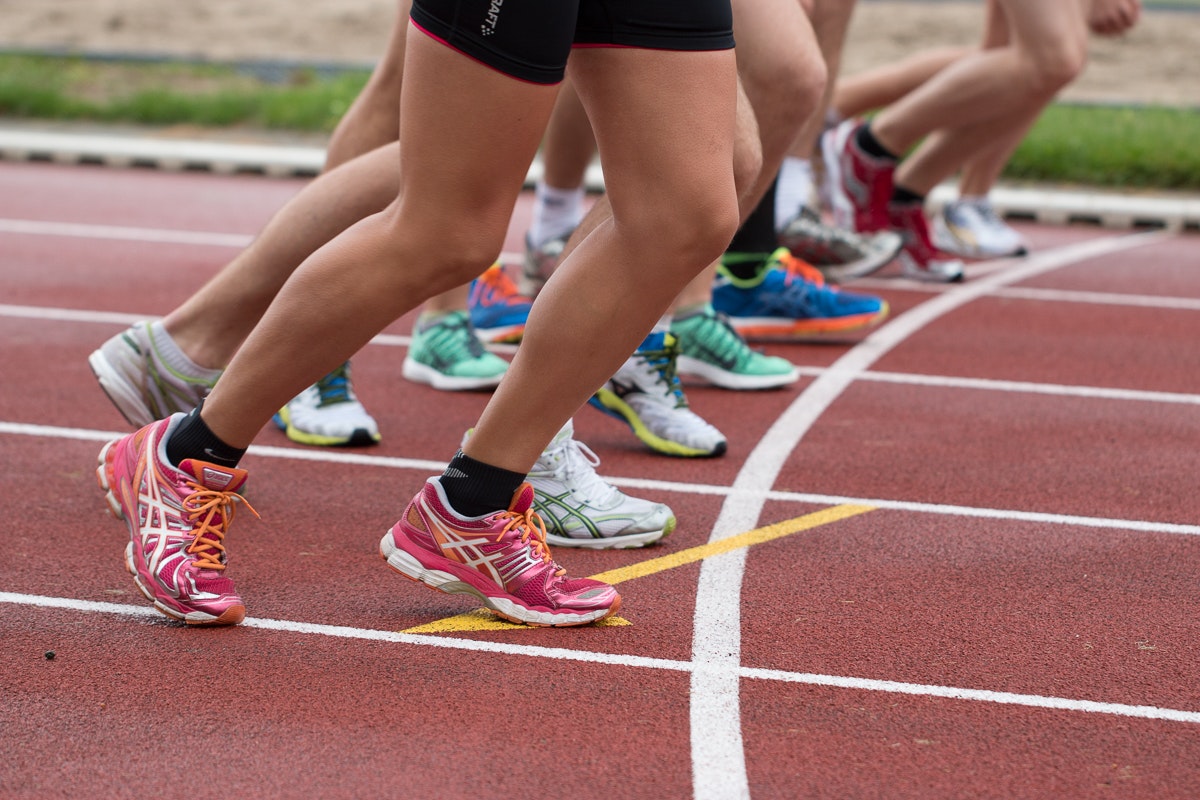
Ultimately, it is your choice which competitors you want to track.
2. Determine Your KPIs
Quantitative metrics are measurable and indicate growth like website traffic or ROI. Qualitative are descriptive and insightful, such as tone of voice or customer sentiment.
When choosing which metrics to track, you need to look at your business and social media goals. See what KPIs you currently have in place and how you are measuring your ROI.
The metrics we usually measure include follower count, follower growth, number of posts, reach, and engagement rate, but you don’t have to just choose quantitative metrics. You can gather qualitative metrics, as well, such as tone of voice, quality of photos or videos, and how your competitors are interacting with their followers through comments and mentions. This kind of data can help you craft social media content that is more effective for engaging with your audience.
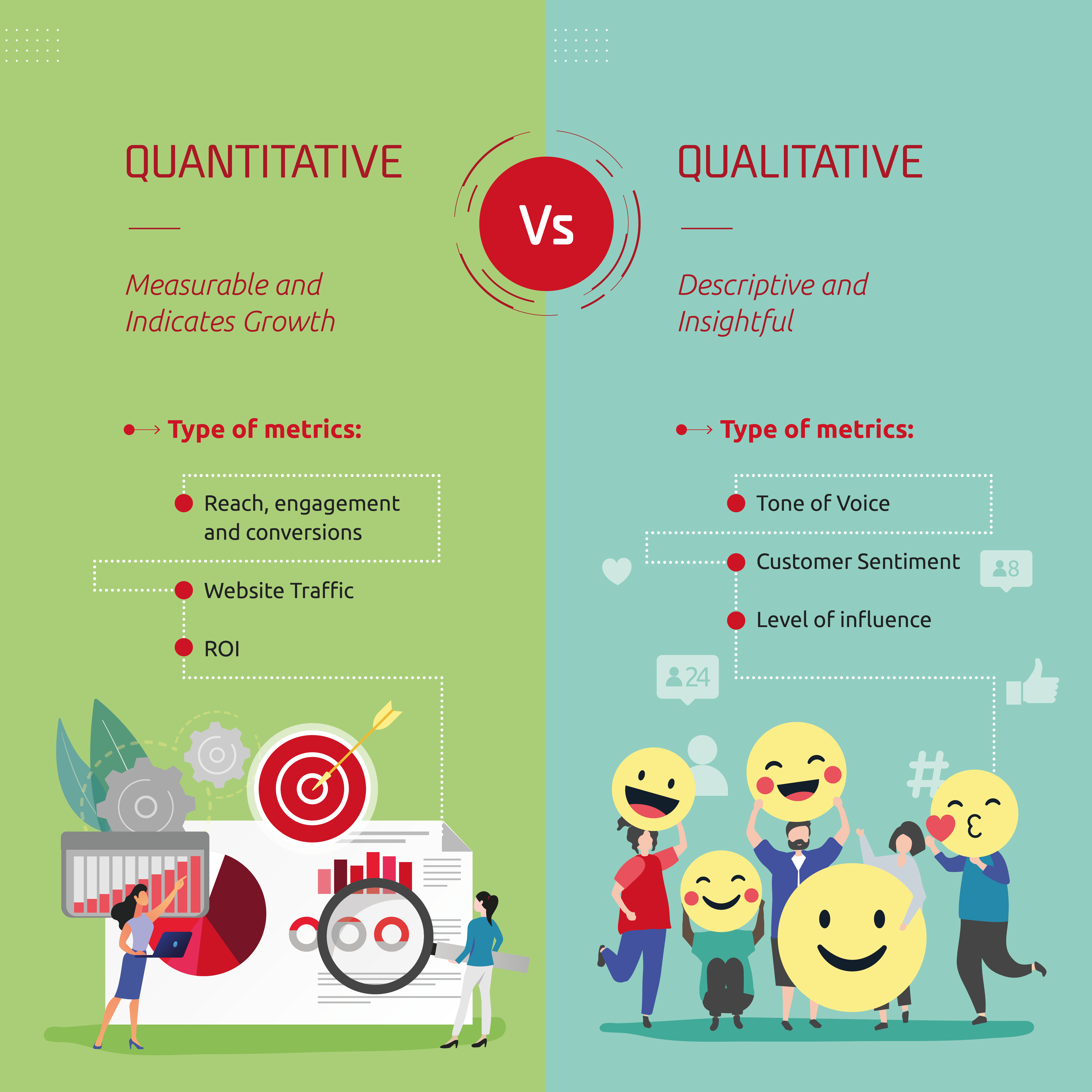
3. Conduct Your Analysis
There are two options to choose between when gathering data for your benchmarking analysis. You can either go with the manual approach or the automated approach.
As you may assume, the manual approach takes significantly more time and there are limitations to the type of data you can gather. But, if you have a limited marketing budget, this may be the only option available to you. Some places you can gather data from are Google Analytics, LinkedIn or Facebook Insights.
Another downside to this approach is figuring out how you will display all of this data. Many choose to build out their own reports, while some who are more daring and have more time on their hands choose to build complex interfaces. We have developed our own reporting module that allows our clients to track their KPIs and receive customized reports on a monthly or quarterly basis. This service is called the Marketing Health Check. If you would like to learn more about this service, please drop us a line.
The easier approach is finding a tool that can automate all of this work, but again, this will be the more expensive option. There are hundreds of social media benchmarking applications you can choose from. Each tool has its own capabilities and limitations to gathering and displaying data. It’s extremely important to do your research and pick the tool that best fits your needs.

Here are a few social media benchmarking tools you can choose from:
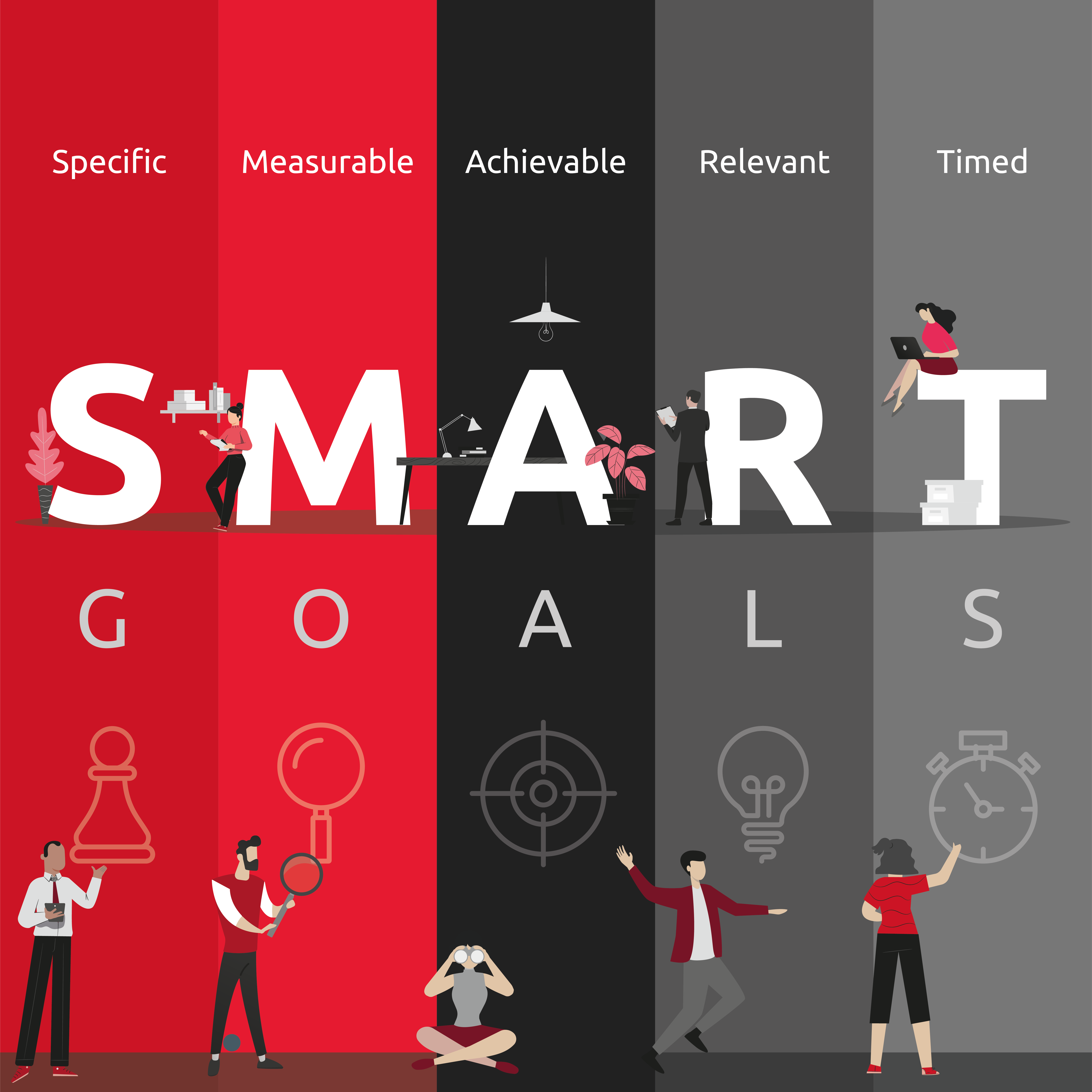
4. Update Your Social Strategy
Now that you have gathered all this data, it’s time to do something with it! After reviewing your data, it should be clear where you need to make changes to your social media strategy. This is a good time to update your goals or set new ones.
When setting goals, you want to make sure they are SMART goals. This acronym stands for Specific, Measurable, Attainable, Relevant and Time-based. By developing objectives in this way, you are more likely to achieve them.
5. Establish Social Listening Practices
This last step is often overlooked but is very crucial to creating a healthy and dynamic social media presence. Through social listening, you can stay on top of trends, discover what conversations your fans or prospects are engaging with, and gather more data on your competitors.
When deciding which benchmarking tool to use, we suggest seeing if they have a social listening component. Keep in mind, there will likely be an additional fee when adding this new feature.

Social media benchmarking is not a one-time project. This is an exercise we encourage you to conduct on an annual or biannual basis. By continuing with this process, you are guaranteeing fresh and timely content for your followers and providing your stakeholders with concrete results.
As we mentioned before, social media is always evolving. Make sure you are seeing an actual return on investment for all your social media efforts.
Looking for more marketing expertise?
Sign up for our newsletter
"(Required)" indicates required fields
YOU MAY ALSO LIKE…

How to add Video to your Digital Marketing Strategy
Digital marketing without video has become unthinkable. Now more than ever, marketers are using video to get their message across.
Read more
